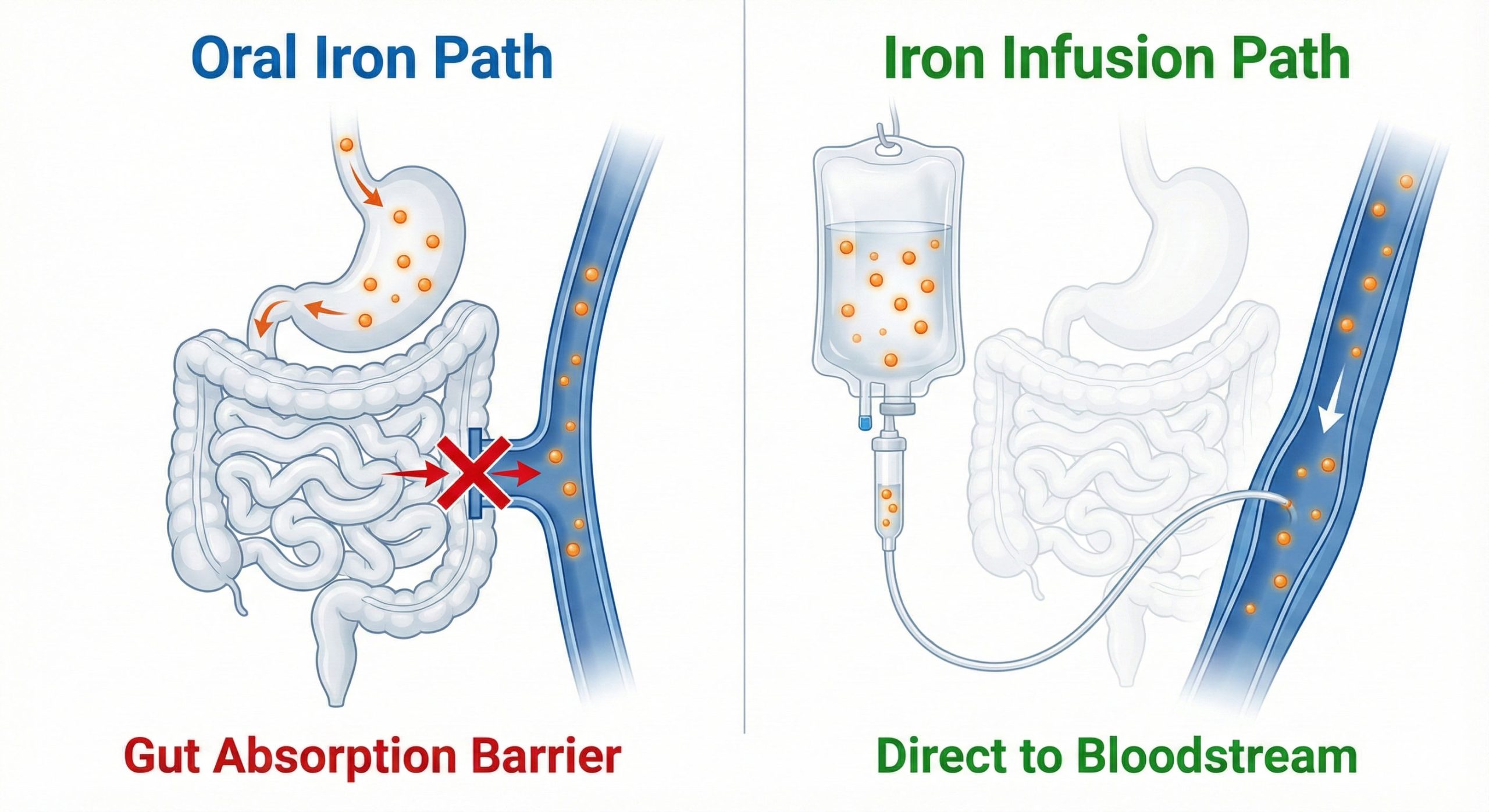Iron is a mineral that plays an essential role in many functions of the human body. It helps produce haemoglobin, the protein in red blood cells responsible for transporting oxygen from the lungs to the rest of the body. Iron also supports muscle metabolism, neurological development, and cellular energy production.
Without enough iron, these vital processes become impaired, which can lead to fatigue, reduced concentration, shortness of breath, and weakened immunity. The body does not produce iron on its own, so it must be absorbed from food or supplements.
In Australia, iron deficiency is a common concern, particularly among women and people with chronic health conditions. In Victoria, treatment options are widely available, including access to iron infusions in Melbourne for those who require medical support beyond oral supplements. Maintaining the right balance of iron is important, as both deficiency and overload can cause health issues.
What Is Iron Deficiency?
Iron deficiency occurs when the body does not have enough iron to meet its needs. It is one of the most common nutritional deficiencies globally and can range from mild depletion to severe iron deficiency anaemia. In many cases, the deficiency develops gradually, and symptoms can be subtle at first. Common signs include tiredness, paleness, brittle nails, headaches, and difficulty concentrating. Women of childbearing age, individuals with gastrointestinal conditions, and people following certain diets may be more prone to developing low iron levels. While dietary factors often contribute, underlying medical conditions should also be considered and assessed by a health professional.
How Iron Deficiency Is Diagnosed
Iron deficiency is diagnosed through a combination of blood tests and clinical assessment. A general practitioner may start by checking haemoglobin levels to see whether anaemia is present. Other important blood markers include serum ferritin (which reflects stored iron), transferrin saturation, and total iron-binding capacity. These tests help determine not only whether a person is iron deficient but also the severity of the deficiency. In some cases, further testing may be needed to identify an underlying cause such as gastrointestinal bleeding, poor absorption, or chronic inflammation. Diagnosis should always be confirmed by a qualified healthcare professional before any treatment is considered.
How Iron Infusions Work
An iron infusion is a procedure used to deliver iron directly into the bloodstream through a vein. This method bypasses the digestive system, allowing for faster and more complete absorption in cases where oral supplements are not effective or suitable. The solution used during an infusion usually contains iron combined with a carrier molecule to help it remain stable and reduce the risk of reaction. The amount of iron given, and the number of infusions needed, will vary depending on individual requirements and the specific product used. Most patients receive the infusion while seated or lying down in a medical clinic, often under the care of a GP or nurse.
When Is an Iron Infusion Recommended?
Iron infusions may be recommended when oral iron supplements are poorly tolerated, ineffective, or not absorbed adequately. This is often the case for individuals with chronic digestive conditions, such as coeliac disease, inflammatory bowel disease, or post-bariatric surgery. They may also be appropriate for people with significant iron losses due to heavy menstrual bleeding or ongoing blood loss from another source. In urgent cases, such as late-stage pregnancy with anaemia or severe iron depletion prior to surgery, an infusion may be preferred due to the quicker restoration of iron stores. Recommendations are always made on an individual basis after medical assessment.
Who May Not Be Suitable for Iron Infusions
Not everyone is a suitable candidate for iron infusions. In some cases, other treatments may be more appropriate or safer. You may not be offered an iron infusion if:
- You have a known allergy to intravenous iron products
- You have a history of iron overload conditions such as haemochromatosis
- You are experiencing an active infection or have certain inflammatory conditions
- You have poorly controlled chronic illnesses that may complicate treatment
Your GP will consider your full medical history, current symptoms, and recent test results before deciding whether an iron infusion is the best option for your situation.
Benefits and Limitations of Iron Infusions
Iron infusions offer several advantages, particularly for those who have not responded well to oral supplements. They can restore iron levels more quickly and may lead to noticeable symptom improvement within days or weeks. This makes them especially useful when time is limited, such as before surgery or during pregnancy.
However, there are limitations to consider. Iron infusions may carry the risk of mild side effects, including headaches, dizziness, or temporary changes in taste. Rare but serious reactions, such as allergic responses, can occur and are usually monitored for during and after the procedure. Additionally, iron infusions do not address the underlying cause of the deficiency, which still needs to be investigated and managed appropriately.
What to Expect During the Appointment
Before the infusion begins, you may be asked to complete a short health screening or consent form. A nurse or doctor will insert a small cannula into a vein, usually in your arm, and connect it to the iron solution. If you’d like a more detailed overview of the appointment process, you can read our guide on what to expect during an iron infusion appointment. The infusion itself may take anywhere from 15 minutes to over an hour, depending on the formulation used.
During the appointment, you’ll likely remain seated or reclined and may be monitored for any immediate reactions. After the infusion, there is typically a short observation period. You should be able to resume normal activities soon after, although it’s a good idea to rest for the remainder of the day if you feel tired or light-headed.
Aftercare and Follow-Up
Most people tolerate iron infusions well and do not require significant aftercare. Some may experience minor side effects such as local irritation at the infusion site, fatigue, or flu-like symptoms. These are usually temporary and resolve without treatment. If you experience anything concerning after the infusion, it’s important to contact your doctor promptly.
Follow-up care often involves a repeat blood test a few weeks after the infusion to assess how well your iron levels have improved. Your GP may also review your diet, ongoing symptoms, and any underlying causes that need further attention. In some cases, additional infusions or long-term monitoring may be recommended to maintain healthy iron levels.
FAQs
Q1: How long does an iron infusion take?
A1: The length of the procedure depends on the type of iron used. Some infusions take as little as 15–30 minutes, while others may take over an hour. Your doctor will let you know what to expect before your appointment.
Q2: When will I start to feel better after an infusion?
A2: Some people notice improvements in energy levels within a few days, while others may take a couple of weeks. The speed of response can vary depending on the severity of the deficiency and individual health factors.
Q3: Are iron infusions safe during pregnancy?
A3: Iron infusions are sometimes recommended during pregnancy when oral supplements are not effective or if iron levels are very low. Your doctor will weigh the risks and benefits before recommending this treatment.
Q4: Can I return to work after the infusion?
A4: Many people feel fine to resume normal activities soon after their appointment. However, if you feel tired or experience side effects, it may be helpful to rest for the day.
Q5: Will I need more than one iron infusion?
A5: It depends on your iron levels, medical condition, and response to treatment. Some people require only one infusion, while others may need multiple sessions spaced over time.
Disclaimer
This article is for general informational purposes only and does not constitute medical advice. Always consult a qualified healthcare professional to discuss your specific symptoms, health concerns, and treatment options. Iron infusions should only be administered following appropriate medical assessment and in accordance with Australian clinical guidelines.



